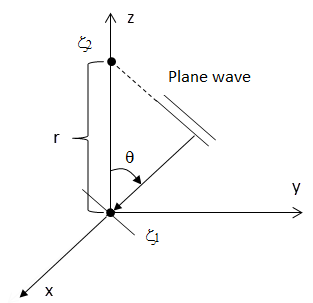Random acoustics deals with a vibro-acoustic system excited randomly, such as the sound field in a reverberant room.
The following topics related to random acoustics are available:
A diffuse sound field is assumed to be a weak stationary random process. It is generally defined in terms of an infinite number of uncorrelated plane waves. The sound field is diffuse only if:
The amplitudes of plane waves from different angles of incidence are statistically independent.
The relative phases of the plane wave are uniformly distributed over
.
The amplitudes are modeled with equal intensity.
Considering plane waves at the two particular points, the first
point is located at the origin while
the second one
is located at the (r, 90o, 0,) in the spherical coordinate system with the
position r = (r,
,
). (Rafaely [427]and Van den Nieuwenhof et al. [428])
The instantaneous pressure of the n
th plane wave at the origin is expressed
as:
(8–203) |
The plane wave at the position (0, 0, z) can be retrieved by the pressure value at the origin:
(8–204) |
The diffuse field pressure at the point is the superposition of an infinite number of plane waves from all directions:
(8–205) |
The cross-correlation function of the pressures at the point and
is
expressed as:
(8–206) |
Assuming that plane waves are uncorrelated and all signals have the same auto-correlation function
, the cross-correlation function
related to all plane waves directions with the element area
on the unit sphere, which is replacing
the element area
in the summation, is:
(8–207) |
After a change of the variable:
(8–208) |
The cross-correlation function is rewritten as:
(8–209) |
Because the power spectral density is the Fourier transformation of the auto-correlation
function
, the function is written as:
(8–210) |
The cross-correlation function is given by:
(8–211) |
Because the cross-power spectral density is the Fourier transformation
of the cross-correlation function
, that is:
(8–212) |
The cross-power spectral density can be expressed
as:
(8–213) |
where:
is the acoustic wave number.
The diffuse sound field is approached by the asymptotic model of plane waves. The plane waves with random phases come from all directions in free space and superposition. The infinite number of plane waves is replaced with a sufficiently high number of plane waves for simulation purposes.
The reference sphere with the radius and origin
are defined. Generally, the radius should be at
least 50x the maximum dimension of the structural panel. The sphere
surface is equally divided into
elementary surfaces so that the
plane waves carry the energy equally in all incident directions. In
practice, the sphere surface is divided into
parallel rings along
the z axis of the global Cartesian coordinate system (default) or
a user-specified local Cartesian coordinate system, and the program
generates the elementary surfaces, each having nearly the same area.
Considering an elementary surface with an outward unit
normal vector
at the center
of
, the acoustic pressure at the point
generated by the plane wave with
the amplitude
and phase
propagating
along
direction,
is defined by:
(8–214) |
where:
(8–215) |
The amplitude of each plane wave is defined by the reference power spectral density and expressed written as:
(8–216) |
In terms of the definition of diffuse sound field, the N phase
angles are uniformly sampled in the range . The sampled diffuse sound field is given by:
(8–217) |
